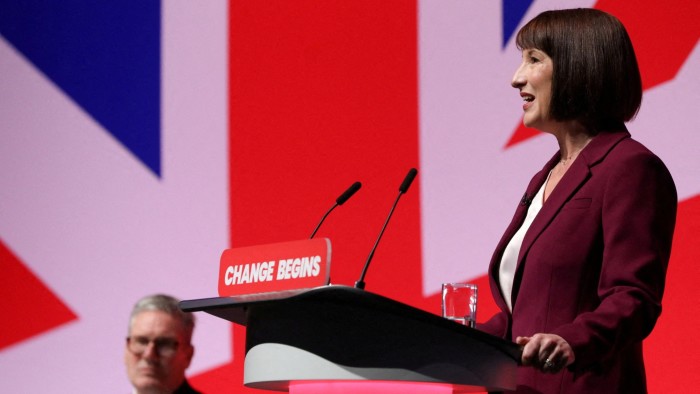Unlock the Editor’s Digest for free
Roula Khalaf, Editor of the FT, selects her favourite stories in this weekly newsletter.
When bond markets get sticky, it is unhelpful to be the ugliest horse in the glue factory. Sadly, that is the role now performed by the UK.
It has been a grim start to the year in global bonds, yet again contrary to what the sharp-suited analysts and professional investors told us to expect for 2025. From the US to Japan, and pretty much everywhere in between, developed-market government bond prices have fallen, shoving yields and borrowing costs higher — a blow for countries going cap-in-hand to investors in search of funding.
The UK, however, has the unhappy distinction of suffering more than most, and given the still-recent memory of the 2022 gilts crisis, alarm bells are ringing. A curious new wrinkle emerged in that tale this week, when the prime minister from that mercifully brief period, Liz Truss, declared through her lawyers that it was unfair to suggest that she crashed the economy at that time. This is a curious move, and one that reflects a poor familiarity with the Streisand Effect.
In any case, the pressing question is whether we are at the start of a new gilts bonfire. The short answer, to my mind, is no. The longer answer is: it is largely out of UK policymakers’ hands anyway.
To be clear, this week’s tumble in gilts is a serious episode. Not all, but many investors have been cooling on UK debt for some time, spooked by signs of persistent inflation that will make it tricky for the Bank of England to keep cutting interest rates. Ten-year yields have pushed up by about half a percentage point since the new government’s Budget at the end of October. That’s a fair chunk in bond land, representing a large fall in prices and including some sizeable drops in the opening days of this week to take long-term yields to the highest since 1998.
More alarming, perhaps, sterling has also taken a knock, suggesting this is not just a case of investors recalibrating their view about what the BoE does next and when, but a scurry away from UK risk more broadly. (Even the share price of Gregg’s has hit the skids, and if you cannot bet on Brits finding the pennies for steak bakes and sausage rolls, something really is amiss.)
Declaring the gilts shake-out to be a new crisis suits the political agenda of some observers. But context here is important. In general, stocks are up in this young year so far, not down, reflecting the tight relationship between the FTSE 100 index, crammed with overseas earnings, and a weaker pound. The same was not true in 2022, when the FTSE got smoked. Yes, a half-point increase in 10-year gilt yields is a lot since the Budget. But in 2022, they jumped by more than that in three days. The two things are just not comparable. And the pound is weaker, sure, but so is the euro, the yen, and everything else other than the mighty dollar.
That’s the key here. The real story is a global ascent in bond yields as the US economy keeps bulldozing ahead of other developed countries and inflation remains above target. In mid-December, the Federal Reserve indicated it would not be as quick to cut rates as investors had previously thought. A few weeks ago, markets reflected expectations that the Fed would snip away at interest rates several times in the opening months of this year. Now we are looking at a chop in the summer, probably, and maybe another later. Friday’s surprisingly robust US jobs data added still more fuel here.
US bond yields, which exert an enormous gravitational force on the rest of global debt markets, are pulling higher, too. US 10-year benchmark yields have gained almost 0.2 percentage points so far this year, and that is throwing the rest of the market out of whack. The UK is in the crosshairs because weaker gilts are boxing chancellor Rachel Reeves in to an awkward spot where she might have to cut spending or jack up taxes. But yields in fiscally strict Germany have risen by a similar degree to the UK’s without generating much fuss.
Aside from the go-go US economic performance, the global pressure on bonds stems from what Nobel Prize-winning economist Paul Krugman this week described as an “insanity premium” on bond yields in the US.
“Increases in long-term rates, like the 10-year Treasury rate, might reflect the horrible, creeping suspicion that Donald Trump actually believes the crazy things he says about economic policy and will act on those beliefs,” Krugman wrote in his blog, a reference to the high trade tariffs, tax cuts and potential mass deportations that point to a renewed surge in US inflation.
So what stops the rot? My sense is it stops itself. US bonds will no longer slide in price once they start to represent an irresistible bargain for investors. This is likely to be if and when 10-year yields get close to 5 per cent, from nearly 4.8 now. The same is probably true for the UK, which for all its woes, is vanishingly unlikely to default on its debt. Big round numbers, in this case five, do have a strong tendency to hammer that message home.
But the awkward scenes on bond trading floors this week are, for Reeves and for the rest of us, a reminder that the US is driving the car for developed markets. We are just passengers and must hope it steers carefully.



